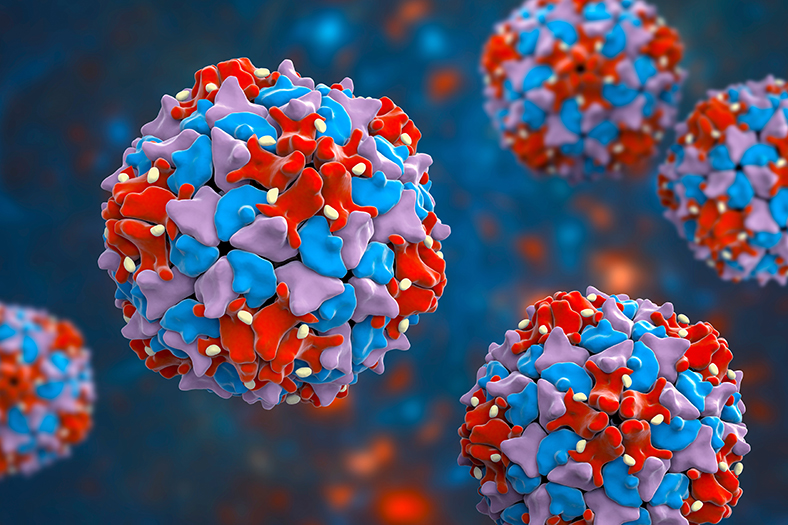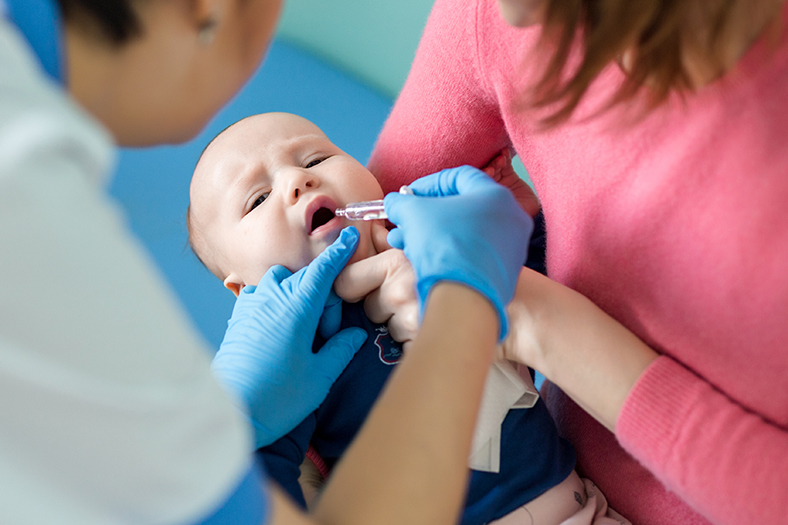Tremendous global efforts have almost rid the world of polio, a highly infectious and debilitating disease, but complete eradication of the virus remains elusive.
With emergent cases making headlines recently, it is important to continue eradication efforts and, although it may not be top of mind for insurers, to address some of the salient issues that bear both interest and ongoing relevance.
About Polio
Poliomyelitis, more widely referred to as “polio,” is an acute, highly infectious illness caused by the poliovirus that can spread from person to person, cause lifelong paralysis, and also result in death. The virus is a single-stranded RNA neurotropic enterovirus. Neurotropic means that the virus has an affinity for nerve tissue – the virus invades the central nervous system (CNS) targeting motor neurons of the spinal cord and brainstem.
The virus is transmitted by the fecal-oral route or oral-oral route, entering through the nasopharynx or gastrointestinal tract. The virus replicates in the pharynx and intestine for between one to three weeks (the incubation period) and spreads to the nerves either via the bloodstream or directly through the axon of the nerve to the CNS. After reaching the CNS, viral replication in spinal motor neurons results in cell death and subsequent paralysis of muscle fibers supplied by the affected motor neuron. One case of polio can potentially infect up to five non-immune contacts, with nearly 100% seroconversion rates among susceptible household contacts of children and greater than 90% among susceptible household contacts of adults. Cases are most infectious immediately before and one to two weeks after the onset of paralytic disease.

While 95% of infections do not result in symptoms or are characterized mild, self-limiting flu-like symptoms, more serious manifestations can occur, such as aseptic meningitis or paralysis. The ratio of asymptomatic to paralytic infections may be as high as 1000 to 1 in children and 75 to 1 in adults.
The disease mainly affects children under five years of age, but unvaccinated individuals of any age can contract the disease and paralytic infection, with death being more common in adults than children. Among adults, pregnant women are the most affected by paralytic poliomyelitis. Unvaccinated people living in areas where immunity levels are low are particularly vulnerable.
One in 200 infections, less than 1% of all infections, leads to irreversible paralysis. Among those paralyzed, 5–10% die when their respiratory muscles are involved. Paralytic disease is generally classified into spinal (the most common), bulbar (brainstem), and bulbospinal (combination) types. Spinal poliomyelitis mainly affects the lower limbs. Two-thirds of patients do not regain full strength, the likelihood of residual deficit corresponding to the severity of the acute weakness. Bulbar poliomyelitis presents with vasomotor disturbances including respiratory failure.
As there is no cure for polio, vaccination is the cornerstone of protection. Management is supportive and symptomatic. Surgery may be required for any deformity or limb dysfunction related to paralysis. Prognosis is variable and gradual, lasting over a year on occasion, and dependent on the severity of the disease.
Post-polio syndrome (PPS) is another clinical outcome of significant concern. This neurological condition causes progressive neuromuscular disability in people who have had polio, usually decades after contracting the disease. After years of stability, variable manifestations may occur, including increased muscle weakness, focal or generalized muscle atrophy (related or unrelated to previously affected muscles), fatigue, pain, and mobility difficulties. Rehabilitation might prevent further deterioration. While rarely life-threatening, PPS can also result in aspiration pneumonia. The cause of progressive neurologic deterioration in PPS is unknown. It is not due to reactivation of virus and is not contagious. Estimates of the incidence and prevalence of PPS vary greatly according to the criteria used for establishing the diagnosis, but the frequency is approximately one third of polio survivors. PPS has a significant impact on quality of life.
Causes
Polio may be caused by either a naturally occurring (wild-type) poliovirus infection or from oral polio vaccination (OPV).
Wild-type virus refers to the naturally occurring poliovirus. Of the three wild type poliovirus serotypes (serotypes 1, 2, and 3) only one – the most virulent wild-type 1 poliovirus (WPV1) - continues to circulate as of October 2021. Type 2 was declared eradicated in September 2015, and type 3 in October 2019. All three serotypes cause motor neuron disease, although most (85%) paralytic diseases in the pre-vaccination era were caused by WPV1. When polio is endemic, it means the paralytic disease is caused by naturally occurring wild-type poliovirus.
Polio can also be caused by the live attenuated OPV virus, which retains the potential to return to a virulent form that can cause paralytic disease, called vaccine-associated paralytic polio (VAPP). VAPP is a rare event, occurring in approximately one person per 2.5 million doses, and is more common in immunodeficient individuals. In developing countries, approximately one-third of VAPP cases are transmitted to a contact of an infant vaccinated with a live attenuated vaccine.
Another form of oral vaccine-related poliomyelitis is vaccine-derived poliomyelitis (VDPV). OPVs work by inducing immunity in the gut. Recipients of OPVs therefore excrete the virus in their stool, which becomes the mechanism of transmission. Despite OPVs being safe and effective, circulating oral poliovirus vaccine-derived polioviruses (cVDPVs) emerge when OPV is used in regions with low immunization rates, i.e., not enough people are vaccinated against polio and the weakened strain of the poliovirus from OPV spreads among under-immunized populations.
2022 Outbreak
In July 2022, a case of polio caused by vaccine-derived poliovirus type 2 (VDPV2) was reported in an unvaccinated individual from Rockland County, New York, who presented with acute flaccid lower limb weakness. The patient had not traveled internationally, suggesting transmission within the country from a person who received a type 2-containing OPV abroad. VDPV2 was detected in the patient's stool and was also identified from wastewater samples, reflecting community transmission. Unvaccinated individuals are at risk for paralytic poliomyelitis if exposed to either wild-type or vaccine-derived poliovirus, hence the advice to stay up to date on recommended poliovirus vaccination.
Similar cases of type 2 VDPV have also been detected in wastewater samples in Jerusalem, Israel, and the U.K. in 2022. OPV is not used in routine immunization schedules in the U.S. or U.K.
History and Vaccination Programs
Epidemics of polio did not occur until the late 19th century, but evidence suggests the disease can be traced back to ancient Egypt, perhaps occurring on a more sporadic basis. Paradoxically, only industrialized countries with improvements in hygiene experienced epidemics, leading to the speculation that in less hygienic times infection was more common at young ages with subsequent development of immunity, reducing the likelihood of permanent paralysis as an outcome. As hygiene improved, young people were less exposed, allowing epidemics to break out.
The first epidemics began in Scandinavia and the U.S. As more was learned about the virus, including its transmission, its presentation, the spectrum of disease it caused, and immunity development, it became apparent that more effective immunity developed from previous asymptomatic infections than by recovery from overt disease. Fear of polio gripped communities: Outbreaks were widely reported in the press, often featuring images of polio victims encased in iron lungs. The announcement of an effective vaccine in 1955 was hailed as a major medical triumph.
Today, two types of polio vaccines are available:
- an inactivated (killed) injected poliovirus vaccine (IPV) - Salk
- a live attenuated oral poliovirus vaccine (OPV) - Sabin

Both vaccines are effective, safe, and used in different combinations worldwide. The choice depends on country-specific epidemiological and programmatic circumstances to ensure optimal population protection. Travelers to epidemic or endemic areas should ensure that they are fully immunized.
IPV is the preferred vaccine for developed countries because it does not cause vaccine-associated paralytic poliomyelitis (VAPP) and can be combined with other routine childhood vaccines. OPV is the preferred vaccine for developing countries due to lower cost, ease of administration, and transmission of vaccine virus to unimmunized contacts.
Tremendous vaccination efforts have brought polio under control and practically eliminated it as a public health threat in many industrialized countries. Developing countries were slower to recognize polio as a major health problem. Limited resources, vaccine storage difficulties, distribution issues, less access to vaccination, and deficiencies in vaccine program performance due to poverty, conflict, and both suspicion and resistance by local leader, have hampered eradication efforts. This continues to be a challenge today. Furthermore, the emergence of cVDPV made the complete elimination of the disease impossible.
Polio was reported in 125 countries when Rotary International launched a global effort to immunize the world’s children against polio. In 1988, the Global Polio Eradication Initiative (GPEI) was established with the goal of eradicating polio globally by 2000. Tremendous progress has been made: Global incidence of polio cases have decreased by 99%, with wild-type polio endemic in only two remaining countries, Pakistan and Afghanistan. Failure to eradicate polio from these last remaining strongholds within 10 years could result in as many as 200,000 new cases every year globally. More than 20 countries, mostly in sub-Saharan Africa and South Asia, have experienced reintroduction of polio from endemic areas because of low population immunity, but reintroduction could occur anywhere.
The long-term goals of GPEI are to interrupt transmission of all wild-type and cVDPV viruses, gradually phase out the use of OPV – given the risk of VAPP and new cVDPV outbreaks and embed the IPV in routine infant immunization schedules globally. Above all, these efforts seek to eliminate the chance of lifelong, disabling polio-associated paralysis and death. Additionally, economic modelling estimated that the eradication would save (mostly low-income) countries at least $40–50 billion.
Surveillance and Eradication
Ongoing surveillance is a crucial component of eradication. After infection, the virus continues to be excreted in the saliva for two weeks and in the feces for two to three weeks, but may continue for longer than six weeks, especially in immunocompromised persons.
Surveillance takes two forms:
- Active reporting and investigation for poliomyelitis in all cases of acute flaccid paralysis (AFP) in children and young adolescents by cell culture testing of stool samples
- Environmental surveillance for circulating wild-type and vaccine-derived polioviruses by periodic sampling of wastewater/sewage in high-risk areas
As fewer polio cases are detected by clinical AFP surveillance, environmental surveillance activities must expand in high-risk and especially in hard-to-reach places.
Other steps toward the eradication of polio include:
- Strengthening both routine and focused vaccine programs and immunization efforts
- Engaging governments and society to commit to reaching every unvaccinated child, particularly those in insecure or remote regions, or in mobile populations
- Recognizing the extraordinary commitment of the public health workforce engaged in the global fight to eradicate polio
- Supporting public health initiatives
- Ensuring sufficient financial resources to see eradication efforts through to completion
Considerations for Insurers
Overall, the mortality risk from all polio cases is extremely low. The case fatality ratio for paralytic polio is generally 2-5% among children, and 15-30% among adolescents and adults, increasing to 25-75% with bulbar involvement. Severe disease manifestations such as aseptic meningitis, paralysis, or complications requiring intensive care unit (ICU) confinement and ventilatory support could impact certain living benefit product lines. Polio is specifically covered by critical illness (CI) policies in some jurisdictions in either designated CI definitions or as part of niche infectious disease riders. Although incidence trends are significantly reduced due to tremendous global vaccination efforts, the risk of polio remains until it is eradicated - a goal that seems well within reach.





